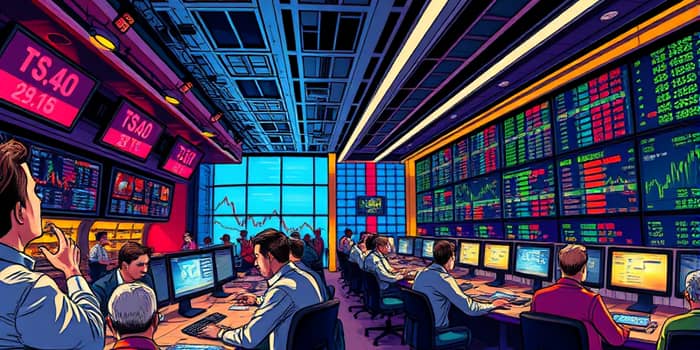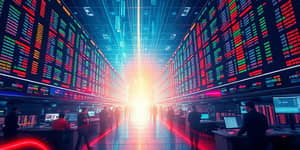
From the crack of dawn in early Wall Street coffeehouses to the hum of fiber-optic data centers, trading has undergone a profound transformation. What once relied on human voices and hand signals now depends on algorithms and global networks. This journey from the physical pits to digital screens reveals not only technological progress but also a story of adaptation, community, and unyielding innovation.
By tracing key milestones and reflecting on the human dimension of each era, we uncover how traders have continuously reinvented their craft. Along the way, we’ll explore the forces that shaped markets, the challenges overcome during moments of crisis, and the promise of emerging technologies that may define the next chapter.
Long before electronic terminals and digital feeds, commerce centered around marketplaces and rallies where goods and securities changed hands in person. As early as 1725, ship captains and merchants gathered in New York coffeehouses to negotiate cargo and share price information.
In 1790, the Philadelphia Stock Exchange emerged as the first organized venue for government securities, followed closely by the creation of the New York Stock Exchange in 1792 under the famous buttonwood tree. These institutions formalized trading and laid the groundwork for regulatory frameworks, ushering in an age of centralized financial marketplaces where trust and standardization became paramount.
By the early 1900s, open outcry defined global trading floors. In glass-domed halls and circular pits, traders used voice and hand signals to convey orders, creating a kinetic, almost theatrical environment. Each pit was dedicated to a specific instrument—futures, commodities, or equities—with brokers on the perimeter relaying client instructions to locals at the center.
This system thrived in hubs like Chicago’s Mercantile Exchange, New York’s NYMEX, and the bustling floors of Kansas City and Minneapolis. The buzzing centers for open outcry fostered camaraderie and split-second decision-making, with seasoned pit veterans reading subtle gestures to seize fleeting market opportunities.
The 19th century brought revolutionary tools that began to erode geographical barriers. The telegraph instantaneously transmitted price information across continents, heralding an era of near real-time long-distance transmission. Ticker tape machines soon followed, delivering a continuous stream of market data directly to trading floors and broker offices.
With the advent of telephones, orders could be placed remotely, enabling participation from the comfort of a broker’s home or a distant office. These innovations planted the seeds for the electronic revolution that would transform market access and speed forever.
The 1970s marked the introduction of computer monitors on the NYSE floor, offering live price quotes and quote comparison across posts. In 1984, the launch of SuperDOT at the NYSE automated order routing, a pivotal leap toward seamless electronic order execution. Charting platforms like eSignal granted traders unprecedented analytical power, ushering in a new era of data-driven strategy.
Throughout the 1980s and 1990s, exchanges deployed systems such as CATS and Globex, gradually phasing out face-to-face pits. By the early 2000s, most major venues—including CME, NYMEX, and MGEX—had closed or significantly reduced their physical spaces. In 2007, the NYSE became a hybrid market, with over 82% of trades executed electronically, though it retained floor auctions for select securities.
The shift from floors to servers delivered markets that were faster, more efficient, and accessible to a global audience. High-frequency trading algorithms execute thousands of transactions per second, while institutional and retail participants enjoy near-zero latency access with reduced transaction costs.
Increased transparency and tighter bid-ask spreads enhanced liquidity, benefiting end investors. Yet, some argue that the disappearance of the human pit floor eroded the nuanced negotiation and market color that skilled pit traders once provided.
Milestone events tested the resilience of both human and electronic systems. On Black Monday in 1987, dramatic losses prompted the introduction of circuit breakers, ensuring trading halts to prevent free-falls. After the September 11, 2001 attacks, the NYSE showcased resilience by reopening quickly, a testament to robust disaster recovery protocols.
During the COVID-19 outbreak in March 2020, markets functioned entirely electronically for the first time, highlighting the critical importance of digital infrastructure and sparking discussions about the future role of legacy trading floors.
Today, a handful of exchanges preserve elements of open outcry. The London Metal Exchange conducts periodic “ring trading,” while the NYSE maintains a symbolic trading floor, arguing that in moments of extreme volatility, human interfacing can deliver better price quality for large, complex orders.
Surrounding these hubs is an ecosystem of high-speed networks, cloud-based analytics, AI-driven decision tools, and direct market access platforms. The evolving landscape favors participants who can merge financial acumen with technological prowess.
Emerging technologies promise further upheaval. Blockchain offers the potential for streamlined settlement and enhanced transparency, though broad adoption remains slow amidst regulatory and technical hurdles. Digital asset platforms are experimenting with new ways to structure markets, while AI and machine learning continue to refine algorithmic strategies.
As we gaze into the future, the industry stands on the edge of another transformation. Whether it’s decentralized ledgers, tokenized assets, or quantum computing-driven analytics, one constant remains: traders will adapt, innovate, and push the boundaries of what’s possible. From the roar of the pit to the silent hum of servers, the spirit of trading endures—ever evolving, ever resilient.
References













